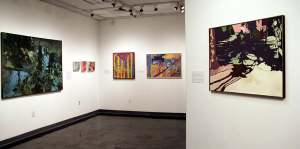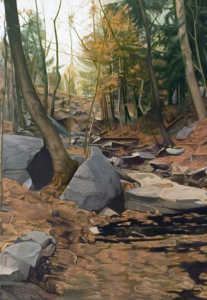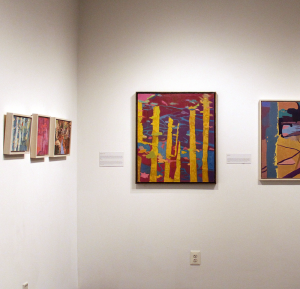
Fourteen paintings by 20th century American abstract artist Ralph Wickiser, including his symbolic depictions of natural scenes and landscapes, are on display in the Spagnuolo Art Gallery in the Edmund A. Walsh Building from Jan. 20 to April 3.
Step inside the Spagnuolo Art Gallery in the Edmund A. Walsh Building and behold an autumn forest, replete with bare trees, a dark stream lined with boulders and a ground coated with orange leaves almost like water itself. For students native to New York, the scene offers a nostalgic taste of home, while for others, it is a trip into the upstate woods that inspired the landscape and other canvas experiments of acclaimed abstract artist Ralph Wickiser (1910- 1998).
Wickiser gained the attention of the American art world for his unique method of depicting the natural world.
“Ralph Wickiser was not a blue-chip artist, but one who was able to still survive and thrive,” Spagnuolo Art Gallery Director Evan Reed said. There is indeed a modesty and subtlety to the exhibit, but the startling impact of the series’ strength is much like the nature depicted in Wickiser’s pieces.
The Spagnuolo Art Gallery is small and intimate, and, like Wickiser, can often be overlooked. The space’s silence wrestles with the movement and liveliness of the paintings. Wickiser’s landscapes fill the room, transforming the humble space into a natural world of wonder and familiarity.

American abstract artist Ralph Wickiser’s work, which is on display in the Spagnuolo Art Gallery, includes The Stream, a scene that is a frequent source of inspiration for Wickiser’s art and became a series of paintings called “Reflected Stream.”
“It’s important for the students to see that you don’t have to stay with one type of art,” Reed also said.
Evolution from the real to the abstract defines the progression of Wickiser’s career, and through his paintings arise themes that question reality and portray nature as somewhat of a human construct.
Following Wickiser’s autumnal portrayal of “The Stream,” the exhibit descends into winter with “Through The Trees,” where the woods have darkened against the white snow. The fluidity in each painted object lends to an overall sense of seasonal change, evoking a sense of human powerlessness over the seasons and nature itself. Given Wickiser’s message that such energy is impossible to pin down and capture, it is almost ironic that he himself attempts to hold sway over natural forces.
The next painting of the series is titled “Pearls and Lace,” a swirling and tumbling sweep of blue and green hues that are difficult to piece together into a concrete image of a landscape. Rather than being the overall image itself, the striking aspect of this painting is the energy and spirit, blind to the humble human eye, but nevertheless extraordinary and stimulating as a source of wonder. Wickiser is a master at garnering appreciation for what is easily overlooked, focusing on the simple beauties of the world around him that he proves are able to thrive independently from humankind.
Wickiser’s paintings indeed act as a mirror reflecting human naivete, a sense emphasized in a collection of three small canvases in the far corner of the gallery. “Reflection I” depicts a red cardinal in a tree, capturing a fleeting moment before it jumps back into the sky. “Red Stream” appears to be a jumble of random shapes, resembling fish and stones spiraling down a stream. Yet, there is still an order to the image as all of the elements share a common color and essence. “Fall Reflections” is an abstraction of a landscape’s reflection in the water. What is fascinating is how the shapes are unclear and ambiguous yet, despite its visceral incoherence, the mind somehow solidifies the image and gives it definition and reality. This miniseries highlights the lack of attention typically given to the natural landscape, and the way people miss moments, ignore them or project onto them their own ideas of beauty.

The height of abstract experimentation in Wickiser’s work presents a strange alienness surrounding the subject of nature. In “Yellow Reflections II,” neon trees reconstruct the standard image of a forest as something vibrant, loud and overpowering. Perhaps Wickiser’s most haunting piece is a canvas titled “Front Lawn,” a painting that evokes the experience of something familiar and transforms it into something new and enchanting. Wickiser’s ability to reshape an ordinary setting illustrates nature’s power to change rapidly and take with it any trace of familiarity.
In his last chronological piece in the series, Wickiser presents an image of the shadow of a tree in the snow, reflecting his earlier years of realism. Another interpretation of this tall, dark figure can be a gaping crack along the earth, symbolizing Wickiser’s work as a whole, splitting open the heart of the landscape to demonstrate the uncertainty and powerlessness of mankind in the face of nature.



















